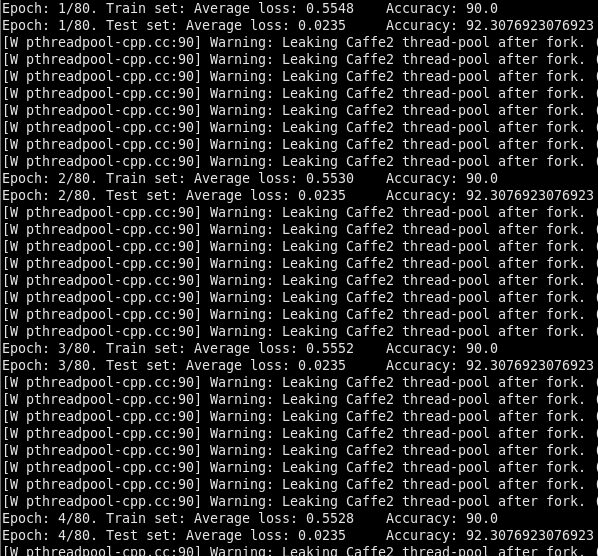Following is the code I am working on:
def train_epoch(train_loader, model, loss_fn, optimizer, cuda, log_interval, metrics, step=None):
for metric in metrics:
metric.reset()
model.train()
losses = []
total_loss = 0
for batch_idx, ((x0, x1), y) in enumerate(train_loader):
y_true = y
x0, x1, y_true = x0.cuda(), x1.cuda(), y.cuda()
optimizer.zero_grad()
output1, output2 = model(x0, x1)
#p_dist = torch.nn.PairwiseDistance(keepdim=True)
p_dist = torch.nn.CosineSimilarity(dim=1, eps=1e-08)
dy = p_dist(output1, output2)
dy = torch.nan_to_num(dy)
y_true = torch.nan_to_num(y_true)
'''2 lines indicated the normalization of dy to 0 and 1 by dividing it with max value'''
maximum_dy = torch.max(dy)
maximum_dy = torch.nan_to_num(maximum_dy)
dy = dy / maximum_dy
maximum_y_true = torch.max(y_true)
maximum_y_true = torch.nan_to_num(maximum_y_true)
y_true = y_true / maximum_y_true
#dy = torch.squeeze(dy, 1)
input_dy = torch.empty(dy.size(0), 2)
input_dy[:, 0] = 1 - dy
input_dy[:, 1] = dy
y_true_2 = torch.zeros(dy.size(0), 2)
y_true_2[range(y_true_2.shape[0]), y_true.long()] = 1
m = nn.Sigmoid()
loss = loss_fn(m(input_dy), y_true_2)
loss.backward()
optimizer.step()
losses.append(loss.item())
total_loss += loss.item()
input_dy_metric = torch.round(input_dy)
for metric in metrics:
metric(input_dy_metric, y_true_2)
metric.total += y_true_2.shape[0]
if batch_idx % log_interval == 0:
message = 'Train: [{}/{} ({:.0f}%)]\tLoss: {:.6f}'.format(
batch_idx, len(train_loader),
100. * batch_idx / len(train_loader), np.mean(losses))
for metric in metrics:
message += '\t{}: {}'.format(metric.name(), metric.value())
losses = []
total_loss /= (batch_idx + 1)
return total_loss, metrics
def test_epoch(val_loader, model, loss_fn, cuda, metrics, log_interval):
with torch.no_grad():
for metric in metrics:
metric.reset()
model.eval()
val_loss = 0
losses = []
for batch_idx, ((x0, x1), label) in enumerate(val_loader):
x0, x1, y_true = x0.cuda(), x1.cuda(), label.cuda()
output1, output2 = model(x0, x1)
#p_dist = torch.nn.PairwiseDistance(keepdim=True)
p_dist = torch.nn.CosineSimilarity(dim=1, eps=1e-08)
dy = p_dist(output1, output2)
dy = torch.nan_to_num(dy)
y_true = torch.nan_to_num(y_true)
'''2 lines indicated the normalization of dy to 0 and 1 by dividing it with max value'''
maximum_dy = torch.max(dy)
maximum_dy = torch.nan_to_num(maximum_dy)
dy = dy / maximum_dy
maximum_y_true = torch.max(y_true)
maximum_y_true = torch.nan_to_num(maximum_y_true)
y_true = y_true / maximum_y_true
#dy = torch.squeeze(dy, 1)
'Output tensor of dimension [4,2] and input tensor of dimension [4,2] to BCE loss function'
input_dy = torch.empty(dy.size(0), 2)
input_dy[:, 0] = 1 - dy
input_dy[:, 1] = dy
y_true_2 = torch.zeros(dy.size(0), 2)
y_true_2[range(y_true_2.shape[0]), y_true.long()] = 1
m = nn.Sigmoid()
loss = loss_fn(m(input_dy), y_true_2)
losses.append(loss.item())
val_loss += loss.item()
input_dy_metric = torch.round(input_dy)
for metric in metrics:
metric(input_dy_metric, y_true_2)
metric.total += y_true_2.shape[0]
if batch_idx % log_interval == 0:
message = 'Test: [{}/{} ({:.0f}%)]\tLoss: {:.6f}'.format(
batch_idx, len(val_loader),
100. * batch_idx / len(val_loader), np.mean(losses))
for metric in metrics:
message += '\t{}: {}'.format(metric.name(), metric.value())
#print(message)
losses = []
val_loss /= (batch_idx + 1)
return val_loss, metrics
loss_fn = torch.nn.BCELoss()
#loss_fn = torch.nn.ContrastiveLoss(pos_margin=0, neg_margin=1)
lr = 1e-4
optimizer = optim.Adam(model.parameters(), lr=lr)
scheduler = lr_scheduler.StepLR(optimizer, 8, gamma=0.1, last_epoch=-1)
n_epochs = 80
log_interval = 1
fit(train_loader, test_loader, model, loss_fn, optimizer, scheduler, n_epochs, cuda, log_interval, [metrics.Binary_accuracy()])
Fit function:
def fit(train_loader, val_loader, model, loss_fn, optimizer, scheduler, n_epochs, cuda, log_interval, metrics,
start_epoch=0, message=None) -> object:
for epoch in range(0, start_epoch):
scheduler.step()
for epoch in range(start_epoch, n_epochs):
scheduler.step()
# Train stage
train_loss, metrics = train_epoch(train_loader, model, loss_fn, optimizer, cuda, log_interval, metrics)
message = 'Epoch: {}/{}. Train set: Average loss: {:.4f}'.format(epoch + 1, n_epochs, train_loss)
for metric in metrics:
message += '\t{}: {}'.format(metric.name(), metric.value())
val_loss, metrics = test_epoch(val_loader, model, loss_fn, cuda, metrics, log_interval)
val_loss /= len(val_loader)
message += '\nEpoch: {}/{}. Test set: Average loss: {:.4f}'.format(epoch + 1, n_epochs,
val_loss)
for metric in metrics:
message += '\t{}: {}'.format(metric.name(), metric.value())
print(message)
